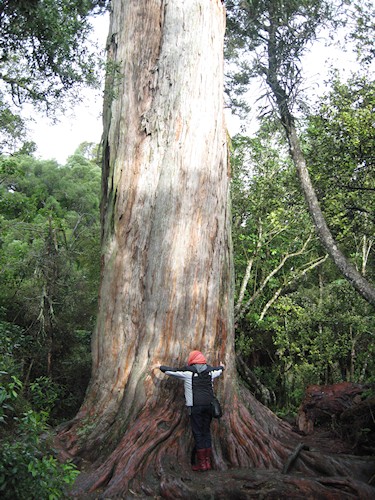What Does it Look Like?
The Totara is one of the majestic forest canopy trees. A mature Totara tree reaches up to 30 metres, although this takes over 100 years. The leaves are 2.5 cm long, narrow at both ends and are dull brownish-green. They are stiff and prickly to touch. Totara is also recognised by the distinctive bark, which flakes off in thick brown slabs. Like all podocarps, Totara trees have cones – male and female cones grow on separate trees. In autumn the female trees produce tiny green seeds which grow on top of the distinctive juicy red base. This is particularly attractive to birds.
Where does it grow?
The Totara is found in forests in both the North and South Islands, although it is most common in the northern half of the North Island. In mountain areas above 600 metres, Totara is replaced by the closely related Thin Barked Totara. The Totara is a particularly hardy tree, and will grow in almost any soil and situation. It is tolerant of both wet and dry conditions, and can withstand windy sites. Totara is a common sight in paddocks in Northland, where it survives because stock don’t like to eat the prickly leaves.
Used To ….
The huge Maori waka taua, capable of carrying 100 warriors, were often hollowed out from a single Totara log. Often the tree was chosen long before it was felled, and the east side of the trunk cut at the base to make it easier to cut the tree down in the future. The Maori also used the wood for large carving and framing for whare (housing). The inner bark was used for roofing and for storage containers – the outer bark as a splint for fractured bones. A pointed Totara stick could be scraped on a slab of softer wood such as mahoe to make, fire. Medicinally, the smoke was a cure for a skin complaint, and boiled bark was used to reduce a fever. A valued food, the Maori collected the bright red fruit which are sweet and juicy with a slightly piney flavour. Since European times, huge areas of Totara have been felled to supply general building timber, railway sleepers, telephone poles etc.
Did you know?
After the Kauri, the Totara may be the longest living tree of the NZ forest – attaining an age of 1000 and more years. The botanical name, Podocarpus totara, is an example of blending the old Latin names – Podocarpus – for the genus, with the Maori – Totara – for the species.
Maori name: Totara
Common name: Totara
Botanical name: Podocarpus totara
